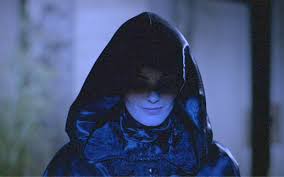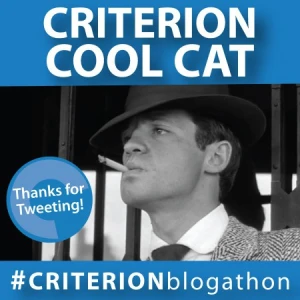 Hubrisween Central ♠ Letterboxd Page
Hubrisween Central ♠ Letterboxd Page
 So it’s 1972, and two recent graduates from UCLA, Richard Blackburn and Robert Fern, decide to make a feature film. Count Yorga, Vampire had been a hit recently, so they decide a vampire movie makes sense commercially – and then they proceed to make a fairly uncommercial movie.
So it’s 1972, and two recent graduates from UCLA, Richard Blackburn and Robert Fern, decide to make a feature film. Count Yorga, Vampire had been a hit recently, so they decide a vampire movie makes sense commercially – and then they proceed to make a fairly uncommercial movie.
It’s the Depression, and gangster Alvin Lee (William Whitton), on the run after gunning down his unfaithful wife and her lover, is drawn by mysterious gazing eyes to a house in the middle of nowhere, where he finds his shotgun is useless against the caped figure welcoming him. Then some guys in capes – and hats! – subdue him.
Meanwhile, his daughter Lila Lee (Cheryl “Rainbeaux” Smith in her first billed feature role) is trying to live down her unfortunate parentage at a small church, where she’s been a ward for three years. She has a large role in the services as “The Singin’ Angel”, and as the story progresses, we’ll see there’s not a small amount of sexual tension between herself and the Reverend (played by director Blackburn). Incidentally, Lila is only supposed to be 13 years old, here, though Smith is obviously not. Lila receives a letter from “Fellow Christian” Lemora that her father is on his deathbed, and is calling for her. So Lila does the Christian thing and goes to him, so she can forgive him.
 She leaves late at night and has to catch a bus seemingly in downtown Gomorrah. It’s a strange, dilapidated bus, the only one that goes to her destination, and it only runs at night. The exceptionally creepy driver (Hy Pyke) says he doesn’t make the run very often. The people there are strange, and too many of them have what is called “the Astaroth look”. Strange man beasts roam the woods, and eventually waylay the bus; Lila is only rescued by the intervention of those mysterious men in capes and hats.
She leaves late at night and has to catch a bus seemingly in downtown Gomorrah. It’s a strange, dilapidated bus, the only one that goes to her destination, and it only runs at night. The exceptionally creepy driver (Hy Pyke) says he doesn’t make the run very often. The people there are strange, and too many of them have what is called “the Astaroth look”. Strange man beasts roam the woods, and eventually waylay the bus; Lila is only rescued by the intervention of those mysterious men in capes and hats.
 After a night of captivity in a small cottage, Lila escapes and runs into – finally – Lemora (Lesley Gilb), a striking, pale figure in black Victorian dress. Folks, We knew from that opening sequence that she was a vampire, so there’s not much of a spoiler there. She’s found something in Lila’s innocence that she must possess (and turn her into a vampire). After a lot of bizarre escapades playing with Lila’s unsophisticated, unworldly nature, she finally sees Lemora putting the bite on one of the children that are constantly hanging around being creepy. Lila finally listens to what we have been shouting at the screen the whole time, and tries to run away, leading to a very lengthy – but good – chase sequence.
After a night of captivity in a small cottage, Lila escapes and runs into – finally – Lemora (Lesley Gilb), a striking, pale figure in black Victorian dress. Folks, We knew from that opening sequence that she was a vampire, so there’s not much of a spoiler there. She’s found something in Lila’s innocence that she must possess (and turn her into a vampire). After a lot of bizarre escapades playing with Lila’s unsophisticated, unworldly nature, she finally sees Lemora putting the bite on one of the children that are constantly hanging around being creepy. Lila finally listens to what we have been shouting at the screen the whole time, and tries to run away, leading to a very lengthy – but good – chase sequence.
 Here’s what’s going on: Lemora’s bite apparently reveals a person’s true nature, or something like that. Some become the vampires roaming about in capes and hats, others become the man-beasts lurking in the woods. The vampires have been trying to exterminate the man-beasts, but as the story reaches its climax, the man-beasts are getting organized and retaliating, resulting in a final, internecine battle at what was supposed to be Lila’s initiation ceremony. Apparently the footage of this was not satisfactory, so Blackburn and Fern start playing with the timeline and finally end on a note of abstract ambiguity.
Here’s what’s going on: Lemora’s bite apparently reveals a person’s true nature, or something like that. Some become the vampires roaming about in capes and hats, others become the man-beasts lurking in the woods. The vampires have been trying to exterminate the man-beasts, but as the story reaches its climax, the man-beasts are getting organized and retaliating, resulting in a final, internecine battle at what was supposed to be Lila’s initiation ceremony. Apparently the footage of this was not satisfactory, so Blackburn and Fern start playing with the timeline and finally end on a note of abstract ambiguity.
The initial reaction to Lemora was, um, not good, and the disappointed Blackburn and Fern sold it off and got on with their lives. A drastically-edited and far too dark print circulated on late night TV for ages, which is where I first (sort-of) saw it. There are reports it was better received in France, where they actually got the literary references.
 I don’t know if you got it from my terse description, but the last third of the movie (at least) is obviously Lovecraft’s “The Shadow Over Innsmouth” (that one honks it horn and flashes its brights when “the Astaroth look” crops up), except for the female protagonist and nightgown. This gets strengthened when Lemora tells Lila of the initiation ceremony, which is to be held in a church. “Baptist?” asks the girl. “Much more ancient than that,” answers the amused Lemora. Also name-checked is Machen’s “The White People” and a large dash of LeFanu, though the filmmakers eschew the more overt lesbianism of, say The Vampire Lovers for a more… well, its hard to say innocent vibe, but certainly not as salacious.
I don’t know if you got it from my terse description, but the last third of the movie (at least) is obviously Lovecraft’s “The Shadow Over Innsmouth” (that one honks it horn and flashes its brights when “the Astaroth look” crops up), except for the female protagonist and nightgown. This gets strengthened when Lemora tells Lila of the initiation ceremony, which is to be held in a church. “Baptist?” asks the girl. “Much more ancient than that,” answers the amused Lemora. Also name-checked is Machen’s “The White People” and a large dash of LeFanu, though the filmmakers eschew the more overt lesbianism of, say The Vampire Lovers for a more… well, its hard to say innocent vibe, but certainly not as salacious.
Like another unjustly ignored horror movie of the time, Messiah of Evil (which had its own production problems impacting the ending), Lemora often feels like a European movie (Blackburn says that he wished he had made it in Spanish, which makes sense on an artistic level, but then we’d be talking about this movie as a blueprint for Dagon). There is very strong art direction by Sterling Franck and exceptional costume work from Rosanna Norton. There are some odd filmmaking bobbles that can be laid to it being Blackburn’s first directorial gig (there is an over-reliance on freeze-frames, especially when they start improvising with the storyline in the final scenes), but this is overall a handsome movie, especially for its budget (and it’s a period piece, and it’s shot on 35mm!). I also really admire the spots where Blackburn thriftily realized he could save money on sync sound and found ways to have long dialogue scenes with only Smith’s silent reactions.
Something like this is going to live or die on its actors, and Blackburn hit the jackpot. Cheryl Smith’s quiet, vulnerable naturalism actually helps sell all the outrageous stuff happening around her, and Lesley Gilb is quite striking and imposing as Lemora: never a wasted motion, often a impenetrable island of stillness in a scene. I swear she goes minutes without blinking. She really does deserve to be included in the ranks of great cinematic vampires.
 Even if it does fall apart narratively in its final minutes, Lemora: A Child’s Tale of the Supernatural is that wonder, an actual undiscovered gem from the early 70s. Well, not undiscovered, Synapse’s Don May knew about it and put out a nice restored DVD for its 30th anniversary. But I only knew of it from Michael Weldon’s first Psychotronic Encyclopedia of Film so I could catch that dark, maimed version at 3:30 in the morning on channel 39. That pretty much counts as “undiscovered” these days.
Even if it does fall apart narratively in its final minutes, Lemora: A Child’s Tale of the Supernatural is that wonder, an actual undiscovered gem from the early 70s. Well, not undiscovered, Synapse’s Don May knew about it and put out a nice restored DVD for its 30th anniversary. But I only knew of it from Michael Weldon’s first Psychotronic Encyclopedia of Film so I could catch that dark, maimed version at 3:30 in the morning on channel 39. That pretty much counts as “undiscovered” these days.


